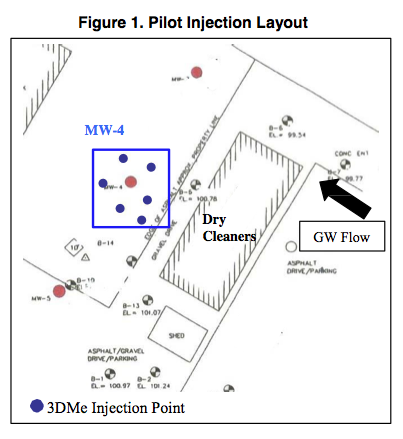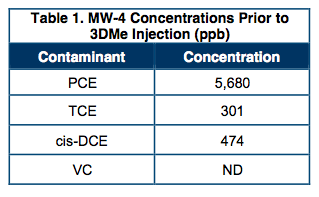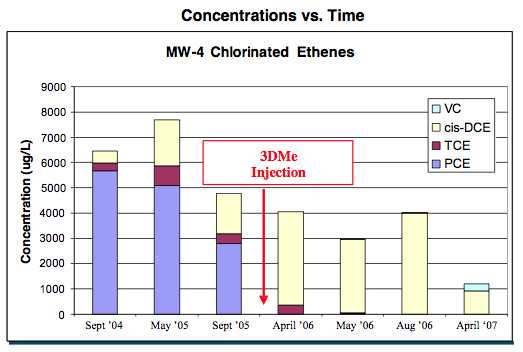3-D Microemulsion® Enhances Reductive Dechlorination and Reduces PCE and TCE Concentrations to Non-Detect
CASE SUMMARY
Operations at a dry cleaning facility in Illinois resulted in elevated levels of chlorinated ethenes in the subsurface. Downgradient of the contaminant source (in Well MW-4), the total chlorinated compound concentration was greater than 6,400 parts per billion (ppb), the main contaminant being tetrachloroethene (PCE). A pilot test using Hydrogen Release Compound (HRC®) was initially designed and deployed to produce conditions favorable for the reduction of contaminants. Well MW-4 was the designated sampling point to observe the contaminant reduction. The HRC pilot application was mis-applied over a 20 foot vertical interval instead of the recommended and planned 10 foot interval, resulting in under-dosing of HRC and only moderate treatment performance. A second application was performed 18 months later using the correct dosing of 3-D Microemulsion (3DMe)®.
REMEDIATION APPROACH
3-DMicroemulsion is a completely new molecule with staged hydrogen release capabilities and is applied as a microemulsion for enhanced distribution. The 3-D Microemulsion was directly injected at 6 locations surrounding the targeted monitoring well MW-4 (Figure 1). It was injected at a rate of 120 pounds per injection point and at 10 to 20 feet below ground surface (at the correct 10 foot interval). The injection points were spaced approximately 7 feet from one another.



RESULTS
Although HRC was applied and under-dosed in September 2004, moderate increases in the reductive dechlorination process were observed near Well MW-4. The moderate effect resulted in a 50 percent decrease in PCE concentrations. As expected some daughter products were also produced.
Within 30 days of the 3DMe application, PCE was reduced from 5,680 ppb to non-detect followed by a similar reduction in TCE. A reduction of 77 percent was observed in cis-DCE between August 2006 and April 2007. Slight increases in vinyl chloride (VC) and ethene indicated that complete dechlorination was occurring with no stalling effect (Table 2).


CONCLUSION
Biostimulation using 3-D Microemulsion was successful in treating the target contaminants as a result of the proper dosing/emplacement of the material and overall product performance. In MW-4, PCE and TCE were reduced to non-detect while total chlorinated compounds were reduced by more than 70 percent.


 Americas
Americas Europe
Europe Français
Français Deutsch
Deutsch Italiano
Italiano Español
Español
